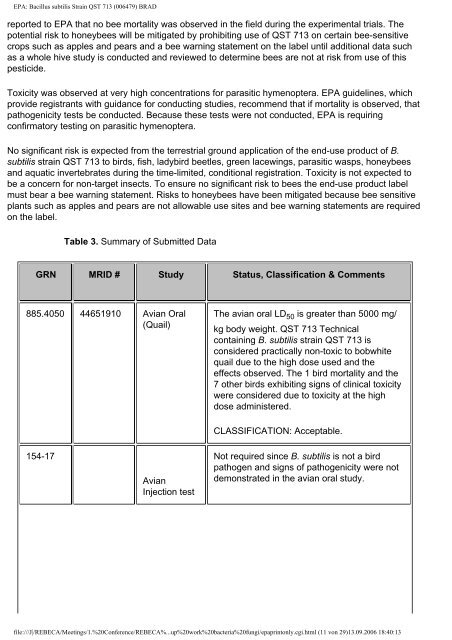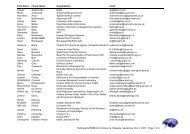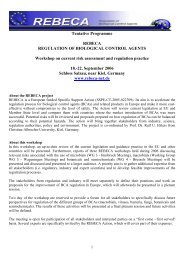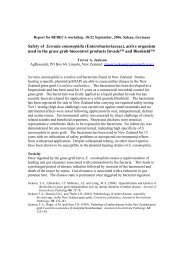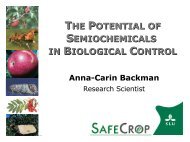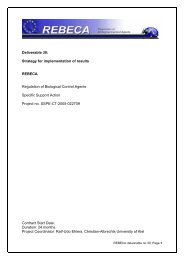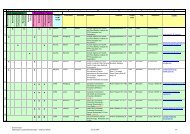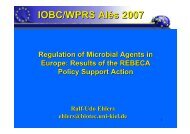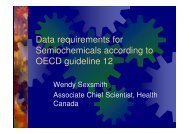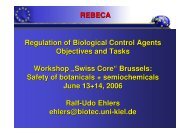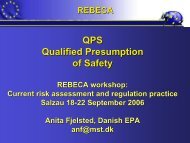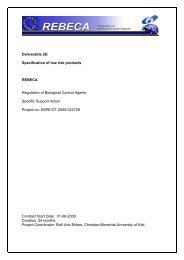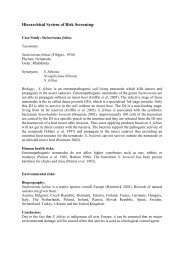EPA: Bacillus subtilis Strain QST 713 (006479) BRAD - REBECA
EPA: Bacillus subtilis Strain QST 713 (006479) BRAD - REBECA
EPA: Bacillus subtilis Strain QST 713 (006479) BRAD - REBECA
- No tags were found...
Create successful ePaper yourself
Turn your PDF publications into a flip-book with our unique Google optimized e-Paper software.
<strong>EPA</strong>: <strong>Bacillus</strong> <strong>subtilis</strong> <strong>Strain</strong> <strong>QST</strong> <strong>713</strong> (<strong>006479</strong>) <strong>BRAD</strong>reported to <strong>EPA</strong> that no bee mortality was observed in the field during the experimental trials. Thepotential risk to honeybees will be mitigated by prohibiting use of <strong>QST</strong> <strong>713</strong> on certain bee-sensitivecrops such as apples and pears and a bee warning statement on the label until additional data suchas a whole hive study is conducted and reviewed to determine bees are not at risk from use of thispesticide.Toxicity was observed at very high concentrations for parasitic hymenoptera. <strong>EPA</strong> guidelines, whichprovide registrants with guidance for conducting studies, recommend that if mortality is observed, thatpathogenicity tests be conducted. Because these tests were not conducted, <strong>EPA</strong> is requiringconfirmatory testing on parasitic hymenoptera.No significant risk is expected from the terrestrial ground application of the end-use product of B.<strong>subtilis</strong> strain <strong>QST</strong> <strong>713</strong> to birds, fish, ladybird beetles, green lacewings, parasitic wasps, honeybeesand aquatic invertebrates during the time-limited, conditional registration. Toxicity is not expected tobe a concern for non-target insects. To ensure no significant risk to bees the end-use product labelmust bear a bee warning statement. Risks to honeybees have been mitigated because bee sensitiveplants such as apples and pears are not allowable use sites and bee warning statements are requiredon the label.Table 3. Summary of Submitted DataGRN MRID # Study Status, Classification & Comments885.4050 44651910 Avian Oral(Quail)The avian oral LD 50 is greater than 5000 mg/kg body weight. <strong>QST</strong> <strong>713</strong> Technicalcontaining B. <strong>subtilis</strong> strain <strong>QST</strong> <strong>713</strong> isconsidered practically non-toxic to bobwhitequail due to the high dose used and theeffects observed. The 1 bird mortality and the7 other birds exhibiting signs of clinical toxicitywere considered due to toxicity at the highdose administered.CLASSIFICATION: Acceptable.154-17AvianInjection testNot required since B. <strong>subtilis</strong> is not a birdpathogen and signs of pathogenicity were notdemonstrated in the avian oral study.file:///J|/<strong>REBECA</strong>/Meetings/1.%20Conference/<strong>REBECA</strong>%...up%20work%20bacteria%20fungi/epaprintonly.cgi.html (11 von 29)13.09.2006 18:40:13


